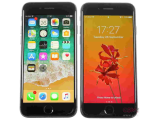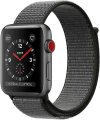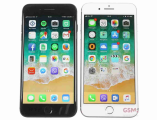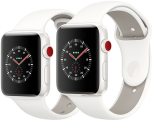Apple iPhone 8 Plus 32 GB Prices
Important Note.
- All prices are in Pakistani Rupee (PKR)
- Prices may vary at stores and our effort will be to provide you with the updated prices.
- Find out WhatMobile price has dropped in Pakistan by selecting Notify Price Drop button
- Find out WhatMobile has better specifications by clicking Add To Compare Button find out what Mobile has better reviews by visiting our reviews section
- Find out WhatMobile is cheaper on which retailer by clicking Compare prices from retailers button
Search Terms
- Apple iPhone 8 Plus 32 GB
Specifications
| GENERAL | |
| 2G Network | GSM 850 / 900 / 1800 / 1900 CDMA 800 / 1700 / 1900 / 2100 |
|---|---|
| 3G Network | HSDPA 850 / 900 / 1700 / 1900 / 2100 CDMA2000 1xEV-DO |
| 4G Network | LTE band 1(2100), 2(1900), 3(1800), 4(1700/2100), 5(850), 7(2600), 8(900), 12(700), 13(700), 17(700), 18(800), 19(800), 20(800), 25(1900), 26(850), 28(700), 29(700), 30(2300) |
| Sim | Nano-SIM - IP67 certified - dust and water resistant - Water resistant up to 1 meter and 30 minutes - Apple Pay (Visa, MasterCard, AMEX certified) |
| BODY | |
| Dimensions | 6.1 mm thickness |
| DISPLAY | |
| Display Size | 5.8 inches |
| Resolution | 1080 x 1920 pixels (~380 ppi pixel density) |
| MultiTouch | Yes |
| Protection | Sapphire crystal glass, oleophobic coating - 3D Touch display & home button - Display Zoom |
| SOUND | |
| AlertTypes | Vibration, proprietary ringtones |
| LoudSpeaker | Yes, with stereo speakers |
| 3.5mm jack | No - Active noise cancellation with dedicated mic |
| MEMORY | |
| CardSlot | No |
| Internal | 32 GB, GB, 4 GB RAM |
| DATA | |
| GPRS | Yes |
| EDGE | Yes |
| Speed | HSPA 42.2/5.76 Mbps, LTE-A (3CA) Cat9 450/50 Mbps, EV-DO Rev.A 3.1 Mbps |
| WLAN | Wi-Fi 802.11 a/b/g/n/ac, dual-band, hotspot |
| Blue Tooth | v4.2, A2DP, LE |
| NFC | Yes (Apple Pay only) |
| USB | v3.0, reversible connector; magnetic connector |
| CAMERA | |
| Camera Primary | Dual 12 MP, (28mm, f/1.8, OIS & 56mm, f/2.8), phase detection autofocus, 2x optical zoom, quad-LED (dual tone) flash |
| Camera Features | 1/3" sensor size @ 28mm, 1/3.6" sensor size @ 56mm, geo-tagging, simultaneous 4K video and 8MP image recording, touch focus, face/smile detection, HDR (photo/panorama) |
| CameraVideo | 2160p@30fps, 1080p@60fps,1080p@120fps, 720p@240fps |
| CameraSecondary | 7 MP, f/1.8, 32mm, 1080p@30fps, 720p@240fps, face detection, HDR, panorama |
| FEATURES | |
| Processor Cores | Quad-Core |
| OS | iOS 11 |
| CPU | Quad-core |
| Sensors | Fingerprint, accelerometer, gyro, proximity, compass, barometer |
| Messaging | iMessage, SMS (threaded view), MMS, Email, Push Email |
| Browser | HTML5 (Safari) |
| Radio | No |
| GPS | Yes, with A-GPS, GLONASS, GALILEO |
| Java | No |
| Colors | Jet Black, Black, Silver, Gold, Rose Gold |
| Others | - Wireless charging - Siri natural language commands and dictation - iCloud cloud service - MP3/WAV/AAX+/AIFF/Apple Lossless player - MP4/H.264 player - Audio/video/photo editor - Document editor |
| BATTERY | |
| Battery | Non-removable Li-Ion 2900 mAh battery (11.1 Wh) |
| MISC | |
Reviews
01/12/2016 - 1:10pm

The iPhone 6 and iPhone 6 Plus were Apple’s biggest releases in recent history. The phones sold exceptionally well and did wonders for Apple’s brand, ecosystem and bottomline. But the iPhone 6 release will be nothing compared to what’s going to happen in 2017.
KGI Securities says that Apple WILL release three models of the iPhone 8 in 2017 and the result will be levels of demand so huge they will dwarf what we saw with Apple’s last truly big seller, the iPhone 6 and iPhone 6 Plus.
The firm reckons Apple is looking at 125 to 150 million sales for 2017 off the back of these new iPhone 8 models. The high demand will be down to a few factors: exciting, new design language; AMOLED display technology; and, finally, new features like wireless charging.
“The report says that wireless charging will feature on all models,” notes 9to5Mac, “making the ‘less-exciting’ devices still very compelling for consumers. The iterative devices will look similar in design to the iPhone 7 but replace their aluminium body with a glass casing, potentially including new cameras and the usual CPU/GPU upgrades.”
2017’s iPhones will look dramatically different to the iPhone 7 as well, with an all-glass chassis, higher resolution displays, minimal-to-no bezels and, according to some rumours, the Home key built directly into the actual display itself. The dual-camera technology will also be revamped, building on from what Apple started with the iPhone 7 Plus.
Whether Apple will update the display resolution remains to be seen. Apple has stuck with 1080p and 720p for its iPhones since 2014, when it launched the iPhone 6 Plus. The smaller, standard iPhone has never been updated and while Apple maintains 720p and its Pixel Display is more than adequate, the price it charges for its phones means this aspect of the iPhone is not acceptable. 1080p should be the minimum.
With the switch to AMOLED panels in 2017, a bump in specs certainly makes sense, especially on the larger, more costly models. But knowing Apple it will only use QHD AMOLED panels on the Pro and Plus models, leaving the smaller, standard iPhone 8 model out in the cold. What I do hope happens is that Apple bumps the standard iPhone 8 display to 1080p and keeps QHD for the more expensive models.
There has been talk about 4K panels in iPhones before, but this seems like a jump too far for Apple. QHD on the AMOLED-using iPhones seems about right and 1080p for the smaller, standard model. This way Apple leaves itself plenty of room to improve in future iterations and is able to claim parity with the likes of Samsung and Google and LG when it comes to display quality.
The combination of updates at both the high-end and low-end will enable Apple to sell more iPhones than in any previous cycle, the report added. Apple’s suppliers are apparently gearing up to produce anywhere between 120 to 150 million units of the new iPhone 8 models – WAY more than the 110-120 million Apple did for the iPhone 6 and iPhone 6 Plus.
This report echoes previous musings we’ve heard about an iPhone 8 Pro model; this handset is tipped to feature a 5.8in OLED display and all the finest technology, whereas the iPhone 8 Plus model will be slightly smaller, but equally potent. The standard iPhone 8 model will bring up the rear, as a more cost effective solution.
So there you have it: three new, completely redesigned iPhone 8 models for 2017.
What's your opinion on this? Let us know in the comments section below.
Write Your Own Review
My Recent Reviews
- Be first to post review for this product.
comments powered by Disqus



























